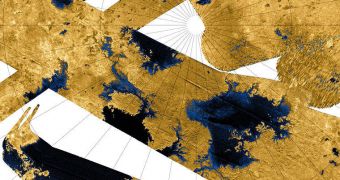Many astrobiologists believe that one of Saturn's moons may contain signs of life. The planet's largest natural satellite, Titan, captured the imagination of astronomers and other scientists when the first data of its surface began to come in. Researchers used data sent back by various spacecraft to determine that the surface of the frigid moon was covered in hydrocarbons, lying under a thick, orange atmospheric layer made predominately out of nitrogen. Given these chemical conditions, coming in contact with lifeforms living on the celestial body could prove to be incredibly difficult, Space reports.
For starters, we might not even realize what is alive down there. The type of chemistry that could underlie the life that may exist on Titan would undoubtedly be significantly different than our own. In all likelihood, experts say, humans would feel disgusted on Titan, primarily due to the toxic smell some of the compounds present on the moon emit. Some of these dangerous chemicals include phosphine and hydrogen sulfide, which are both toxic and lethal to humans. Most likely, our type of chemistry would be very reactive to creatures on Titan as well, and we would be equally as toxic to them too.
“This idea that you can walk up to the alien ambassador and shake their hand is very unlikely,” explains Massachusetts Institute of Technology (MIT) biochemist William Bains. He also holds an appointment at the Rufus Scientific group, in Cambridge, the UK. “They're truly horrible chemicals – to us. But if this sort of life did exist our sort of chemistry would be dangerous and reactive to them,” the scientist adds. Astronomers add that this bizarre chemistry combined with the rather chilly -292 degrees Fahrenheit (minus 180 degrees Celsius) temperatures on Titan make for a very interesting target for space exploration.
“I've taken Titan as an example of a pretty extreme environment where clearly terrestrial biochemistry isn't going to work. Life anywhere else that is radically different from earth is difficult to get your head around,” Bains further explains. He adds that the lakes of liquid hydrocarbons, such as methane and ethane, that adorn the moon's poles, are already targeted by various upcoming space missions, either planned by NASA or the European Space Agency (ESA).

 14 DAY TRIAL //
14 DAY TRIAL //